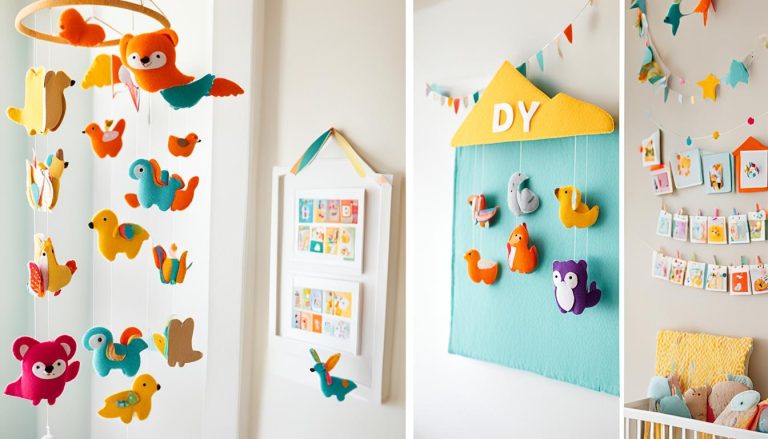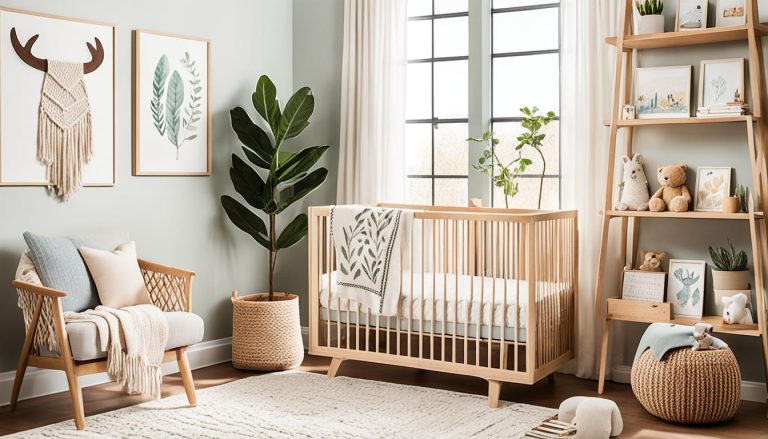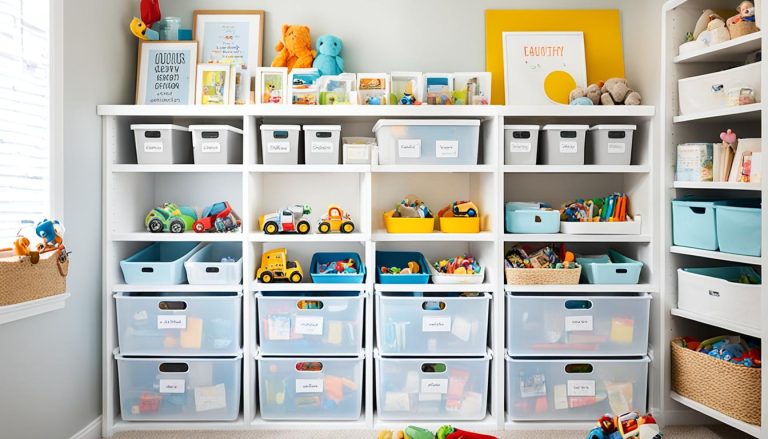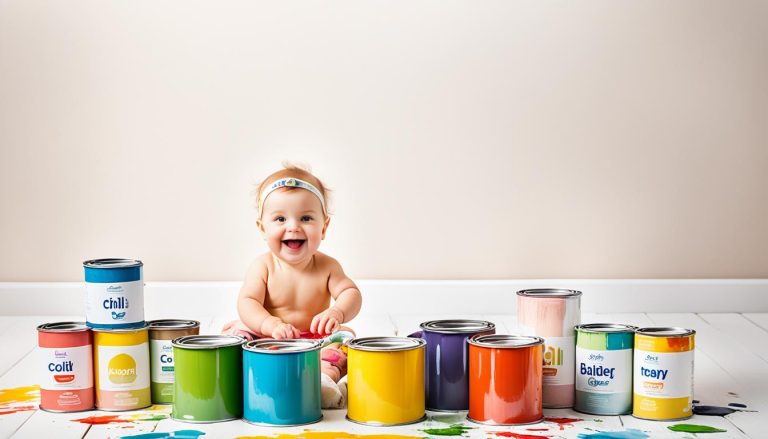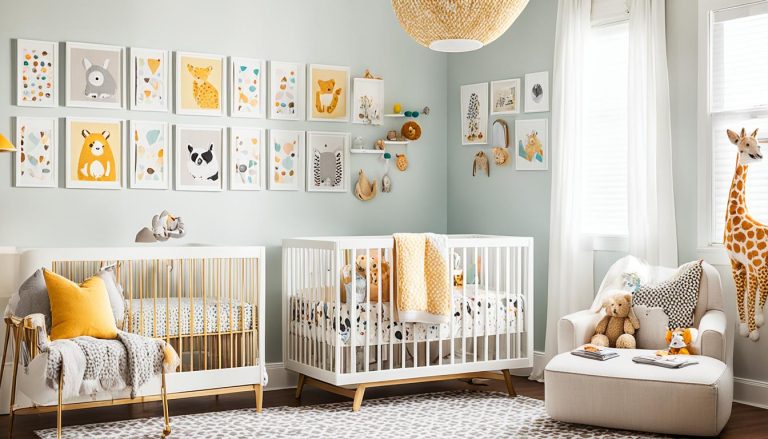Quick Nursery Setup: Setting Up on a Tight Timeline
houseremodelingnews.com may earn a commission if you purchase a product through one of our links
“The best way to get something done is to begin.” – Unknown
Setting up a nursery quickly can feel overwhelming, but it’s doable with a good plan. You can make a cozy space for your baby fast. The key is in the nursery design and baby room decor, which requires careful planning.
Usually, you start planning the nursery around the 18th week of pregnancy. First, pick a theme and set a budget. Then, by weeks 21-23, order your furniture, knowing delivery might take up to 14 weeks.
Between weeks 23-27, paint or wallpaper the room and set up storage. This helps keep everything organized.
For a small room, like 11′ by 12′, focus on essential furniture. This includes a safe crib, a comfy glider, and a dresser that also serves as a changing table. For a nature theme, choose walnut or gray wood furniture with chrome details. Add fun, bright art to make the room welcoming.
Try to have your nursery ready by week 36, in case your baby comes early. With a good plan and efficient steps, you can make a beautiful nursery quickly, even when you’re short on time.
Understanding the Importance of Efficient Nursery Planning
Planning your nursery well is crucial for your baby’s space. It saves time and makes sure you’re prepared before the baby comes. Let’s see why planning matters and how to mix functionality with style.
Why Time is Crucial in Nursery Setup
Starting nursery planning early is smart. Most expecting parents begin around the 16th week of pregnancy. This gives you time to make good choices and avoid last-minute stress.
- Budget planning: 16th-18th week
- Theme selection: 18th-20th week
- Furniture checklist: 21st-23rd week
- Decorating and organizing: 24th week onwards
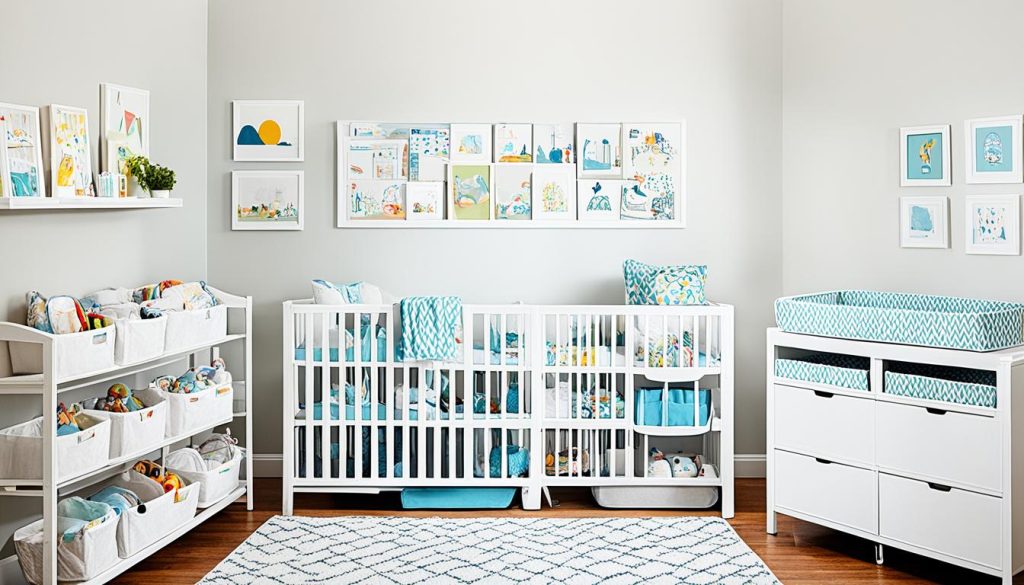
Balancing Functionality and Aesthetics
A nursery should be both useful and lovely. Pick items that do more than one job to make the most of space. For instance, a changing table with storage saves space and keeps things handy.
Setting Realistic Expectations
Creating the ideal nursery takes time. Set realistic goals and focus on what’s most important. Begin with the basics and add decor later. This way, you get a nursery that’s both practical and stylish without rushing.
Understanding efficient nursery planning helps you prepare a welcoming space for your baby. Start early, focus on what’s useful, and enjoy getting ready for your new baby.
Determining Your Nursery Budget
Setting a nursery budget is key during your pregnancy. Aim to do this between the 16th and 18th week. This helps you avoid spending too much and get ready for your baby’s arrival.

- Prioritize essential items
- Look for multi-functional furniture
- Consider second-hand options for certain pieces
- Plan for sales and bargain hunting
The cost of a nursery can vary a lot. In the US, you might spend about $2,000 on basics like a crib and changing table. But, your total could be between $500 to $5,000 or more, depending on what you choose.
Remember, nursery costs are just the start of expenses for your child. It’s smart to set a realistic budget early.
To save money, think about upcycling furniture, doing DIY projects, and borrowing from friends or family. With careful planning and smart choices, you can make a beautiful nursery without spending a lot.
Choosing a Theme and Color Palette
Choosing a nursery theme and color palette is a fun step when preparing for your baby’s arrival. There are many options to pick from, making a space that looks good and works well. Let’s look at some popular choices and tips to help you decide.
Popular Nursery Themes for Quick Setup
If you’re short on time, consider these easy nursery themes:
- Woodland creatures
- Space exploration
- Safari animals
- Ocean life
- Floral garden
These themes have lots of ready-made decor, making it easy to create a unified look fast. For instance, a woodland theme can inspire a love for nature and calm your baby.

Gender-Neutral Options for Flexibility
Choosing a gender-neutral nursery gives you flexibility and saves you money later. About 30% of parents pick this option, liking calming colors like whites or pastels. This way, the nursery can change as your child grows, saving time and money.
Incorporating Existing Decor Elements
To save money and time, use decor you already have in your nursery. More than half of nurseries use furniture they already have, like turning a vintage dresser into a changing table. This adds charm and makes your home look connected.
“A nursery should reflect your personal style while providing a soothing environment for your baby.”
Your color choices can really change the feel of the room. Warm colors like yellow and orange make a room lively, while cool colors like blue and green calm it down. Pick colors that fit your theme and the mood you want for your nursery.
Creating a Comprehensive Nursery Checklist
Creating a detailed nursery checklist is crucial for easy nursery setup. Begin your list around the 20th week of pregnancy. This gives you enough time to gather everything you need. Make sure to include furniture, bedding, clothes, feeding supplies, and safety items.

- Crib with a firm mattress
- Changing table with storage
- Comfortable nursing chair
- Dresser for baby clothes
- Baby monitor
Then, add must-have baby items to your list:
- 3 sets of crib sheets (cotton or bamboo)
- Diaper changing supplies
- Feeding essentials (bottles, pump, storage bags)
- Baby clothes in various sizes
- Bathing supplies
Include safety items in your nursery prep:
- Smoke and carbon monoxide detectors
- Baby-proofing supplies
- Rectal thermometer
- Infant medicine (Tylenol, Motrin)
Think about adding nice-to-have items if you can afford them:
- Sound machine
- Humidifier
- Nightlight
- Mobile with bright colors
- Play mat for tummy time
The average cost for a baby’s first year is about $13,000. Plan your nursery checklist carefully. This way, you can stay within your budget and have all the baby essentials.
Essential Furniture for a Functional Nursery
Setting up a nursery can feel overwhelming, but focusing on key pieces makes it easier. Your baby’s room should be practical and cozy. It should also have space-saving solutions that grow with your child.
Prioritizing Key Pieces
Begin with the must-haves. A crib is crucial for a safe sleep space. Then, get a changing table for diaper changes and a comfortable chair for feeding and bonding.
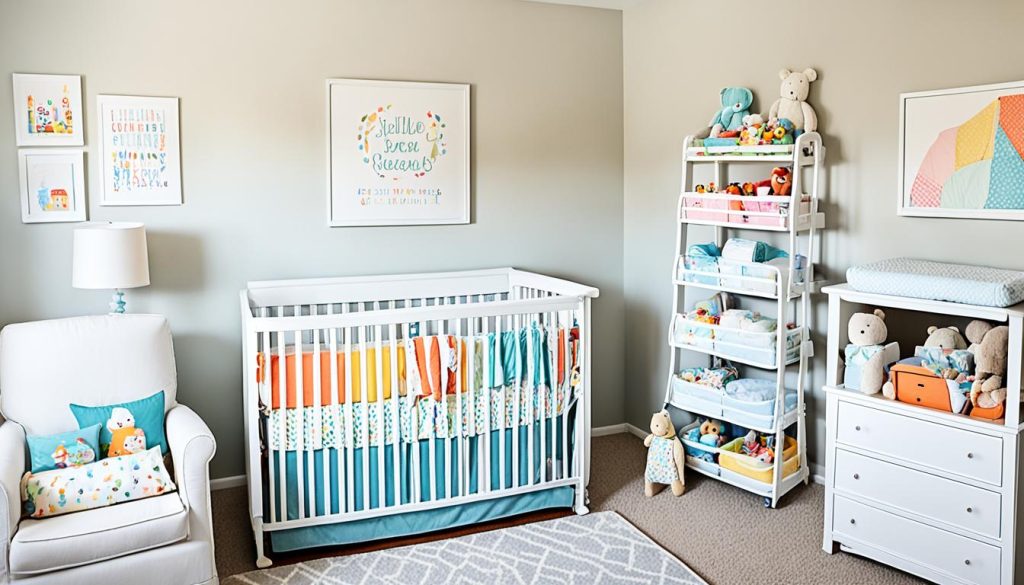
Multi-functional Furniture Options
Use furniture that serves more than one purpose. A crib that turns into a toddler bed is a smart choice. Pick a dresser with a changing pad on top to save space and money as your child grows.
Space-saving Solutions
In small rooms, use furniture that saves space. Wall-mounted shelves are great for storage without taking up floor space. A mini crib is also a good choice instead of a full-sized one.
Look for furniture with built-in storage, like ottomans or benches, to use every inch of your nursery well.
- Use vertical space with tall, narrow dressers
- Opt for a rocking chair that glides to save floor space
- Choose a crib with under-bed storage drawers
Your nursery should be functional and adapt as your child grows. By picking versatile, space-efficient furniture, you’ll have a room that meets your needs now and later.
Maximizing Storage in a Small Nursery
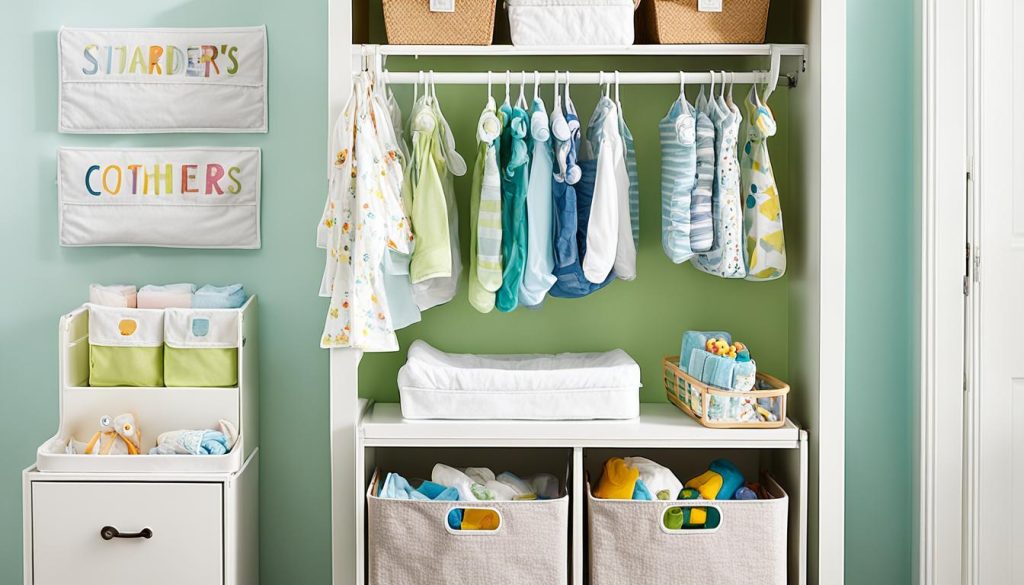
Creating a functional nursery in a small space can be tough. With smart techniques, you can use your space well. Let’s look at some ideas for small nurseries that focus on storage without losing style or comfort.
Vertical space is key in a small nursery. Put up floating shelves or tall bookcases for diapers, wipes, and toys. Over-the-door organizers are great for keeping things you use often within reach.
Choose furniture that does more than one job. A changing table with drawers or an ottoman with hidden storage can increase your storage. A mini crib is also a good choice because it’s cheaper and takes up less room than a full-size one.
- Use under-crib space for storage boxes or drawers
- Install closet organizers to maximize hanging and shelf space
- Utilize corner spaces with triangle-shaped shelves or a corner changing station
Clear storage bins are powerful tools. They help keep drawers tidy and make finding things quick. Sort baby clothes by size early to keep the nursery organized as your baby grows.
“In small nurseries, every inch counts. Focus on multi-functional furniture and creative storage solutions to make the most of your space.”
A clutter-free nursery looks better and is safer for your baby. By using these strategies, you’ll make a cozy and organized space for your little one, even in small rooms.
Quick and Easy Nursery Organization Hacks
Organizing a nursery can seem like a big task, but with the right hacks, you can do it fast. Let’s look at some easy DIY storage ideas for your nursery.
Utilizing vertical space
Make your walls do more! Add floating shelves or a pegboard for extra storage. This trick saves floor space and keeps things you need close by. Use hooks for baskets that hold diapers, wipes, and clothes easily.
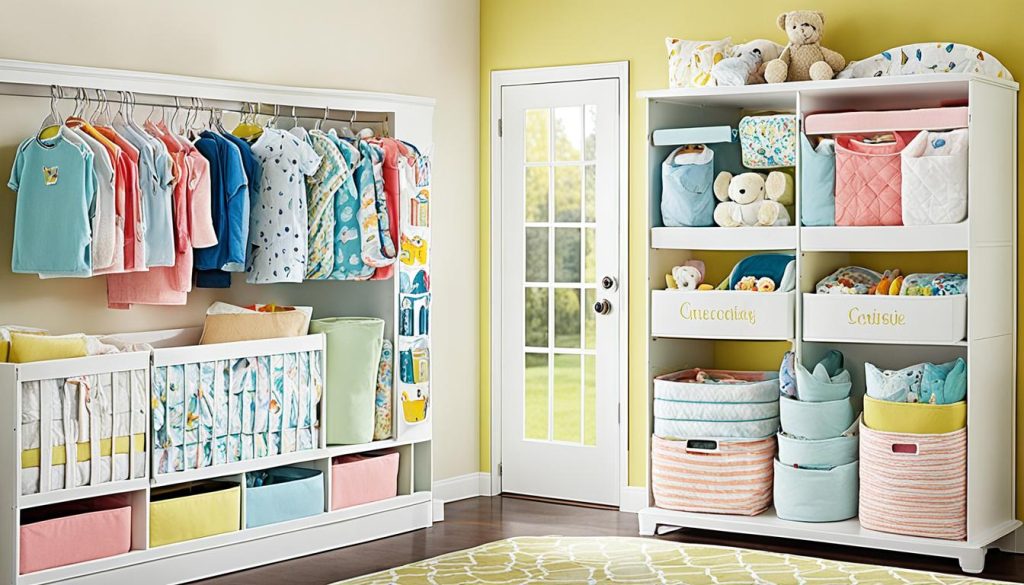
Clever closet organization
Make your closet a storage spot. Use dividers to sort clothes by size, making getting dressed quicker. Add a shoe organizer on the door for diapers, onesies, and small items. For more space, put a second rod below the first one.
Repurposing household items
Be creative with storage! Turn a bar cart into a diaper station on wheels. Use spice racks for books and mason jars for small items like pacifiers and hair accessories. These ideas save money and make your nursery feel more personal.
- Label storage boxes for easy identification
- Use bright, metallic rods to create makeshift closets
- Create a stuffed animal swing for cuddly toy storage
Regular decluttering keeps your nursery organized. With these smart tips, you’ll have a clean and useful space for your baby fast!
Time-Saving Decorating Tips for a Stylish Nursery
Looking for quick nursery makeover ideas? You’re in luck! With these tips, you can make a stunning nursery fast. Focus on key elements that make a big impact.
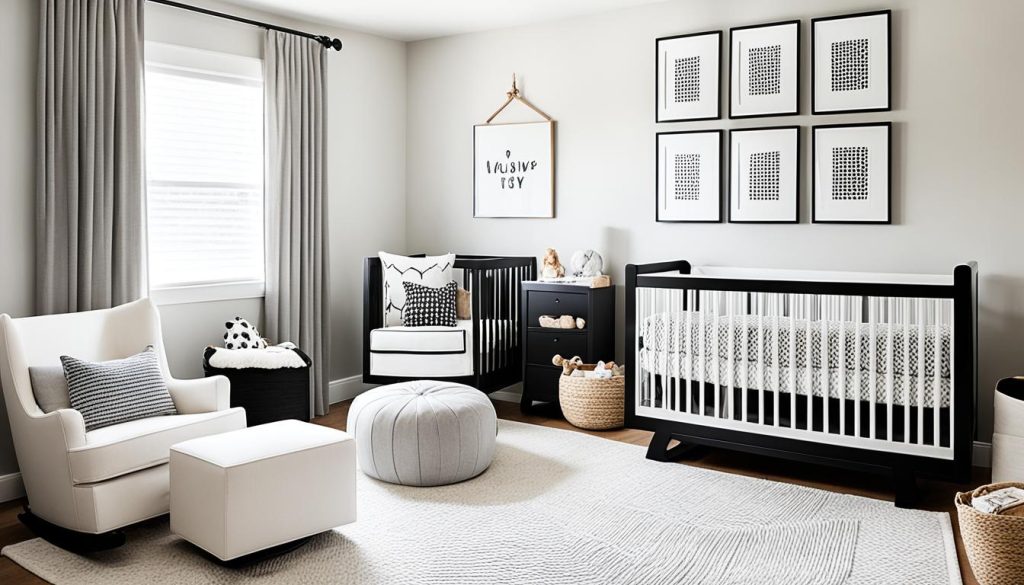
Create a statement wall with washable wallpaper or removable decals. These are great for renters and easy to change as your child grows. Add a colorful rug to tie the room together and provide a soft play area.
Choose neutral furniture that can adapt as your baby gets older. Gray pieces are practical and versatile. Add pops of color with curtains, throw pillows, or artwork. These accessories are easy to swap out for a fresh look.
- Install cabinets above the glider and changing table for extra storage
- Use vertical stripes on walls to add style and make the room feel larger
- Repurpose regular lamps into nightlights with special bulbs
When setting up your nursery, focus on the essentials: a crib, changing table, and glider. Everything else is a bonus. Remember, you can create a gorgeous nursery even in a small space of less than 100 square feet.
“Aim for a soft, classic, and tailored feel with a touch of whimsy in your nursery design,” advises Lauren Sullivan, TODAY.com senior editor.
With these tips, you’ll have a stylish and functional space ready for your baby’s arrival. Start your quick nursery makeover around the 24th week of pregnancy to ensure everything is set up in time.
Setting Up a Nursery on a Tight Timeline
Creating a quick nursery setup can be tough, but with a good plan, you can do it well. Here’s a week-by-week guide to help you manage tasks and share the work.
Week-by-Week Planning Guide
Start planning your nursery in the second trimester, which is the best time, say experts. First, order the must-have furniture and pick a theme. Try to get the main items ready by the 36th week, leaving time for any last-minute things.
- Weeks 16-20: Order crib and dresser
- Weeks 21-24: Select theme and color palette
- Weeks 25-28: Purchase bedding and decor
- Weeks 29-32: Set up furniture and organize closet
- Weeks 33-36: Install safety features and add final touches
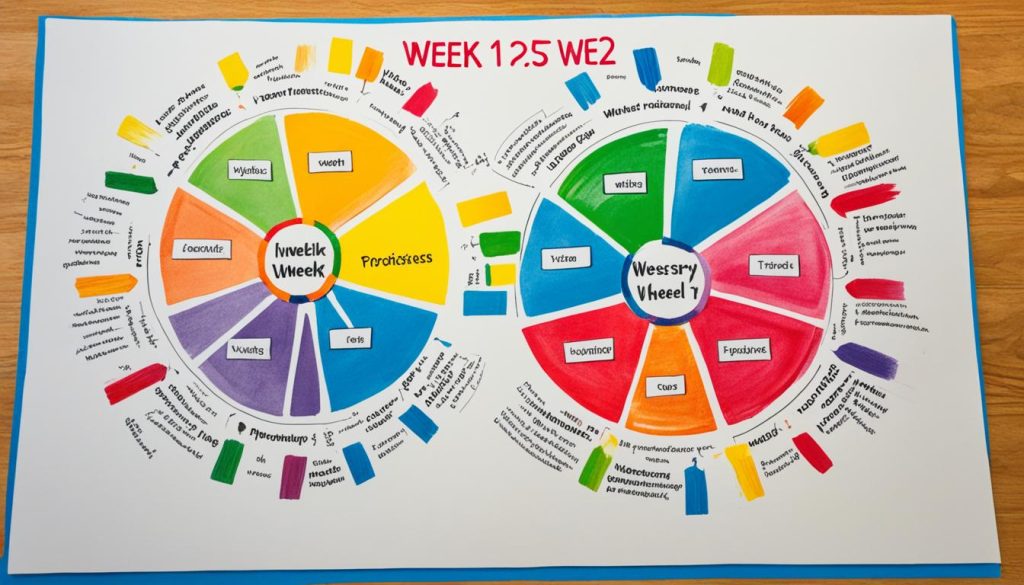
Prioritizing Tasks Effectively
Focus on the key things for your nursery. Make sure you have a safe place for your baby to sleep, a spot for changing diapers, and a place for feeding. Health Canada says cribs, cradles, or bassinets that follow safety rules are the best choices for baby’s sleep.
Delegating Responsibilities
Get help from family and friends for your nursery tasks. Give specific jobs to people you trust to make the setup go smoother. This could be putting together furniture, sorting baby clothes, or checking safety tips.
By using this guide and focusing on what’s most important, you can make a safe and useful space for your baby, even if you’re in a hurry. Always check for recalls and put safety first in setting up your nursery.
Budget-Friendly Nursery Ideas for Last-Minute Setups
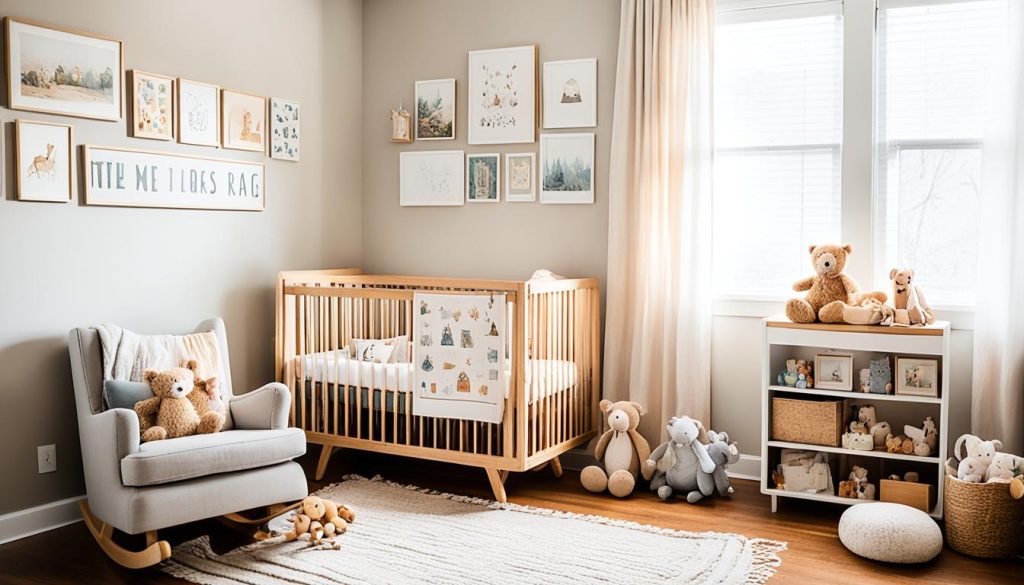
Creating a beautiful nursery doesn’t have to be expensive. With creativity and smart planning, you can make a cozy space for your baby without spending a lot. Here are some budget-friendly ideas for last-minute setups.
DIY projects are a great way to add personal touches to your nursery. Try making a handmade mobile or creating wall art with simple materials. These projects save money and add a unique charm to the room.
For affordable nursery decor, consider second-hand options. You can find gently used furniture and decor at thrift stores or online. With a little cleaning and maybe a fresh coat of paint, these items can look new again.
- Repurpose items from around your house
- Use a dresser as a changing table
- Hang picture-book shelves for storage and decor
- Create a wall-mounted sensory exploration zone
For a last-minute nursery setup, focus on multipurpose items. A dresser can be a changing table, saving space and money. Wall-mounted shelves can hold books and store essentials, being both functional and decorative.
Small changes can make a big impact. Updating drawer pulls or adding a fresh coat of paint to existing furniture can change the nursery’s look without costing much. With these budget-friendly ideas, you can create a beautiful space for your baby, even on a tight timeline.
Safety Considerations for a Quick Nursery Setup
Setting up your nursery quickly doesn’t mean you should forget about safety. A safe sleep area and proper babyproofing are key for your baby’s safety. Focus on important areas to make a secure space for your baby.
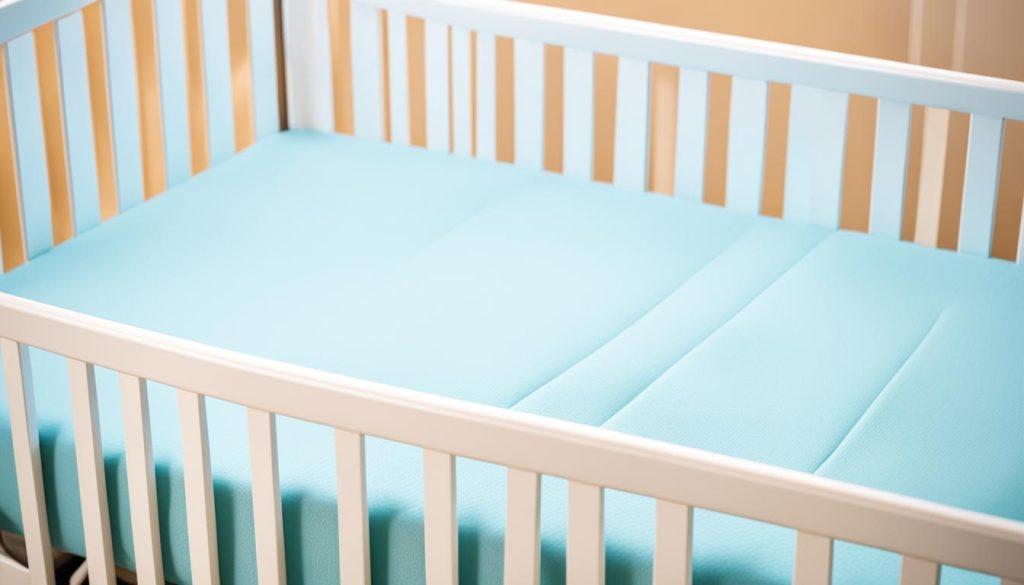
Essential Babyproofing Measures
Start babyproofing early. Cover electrical outlets, secure heavy furniture, and remove dangers. Use window guards and cordless window coverings to avoid accidents. These steps help make your nursery safe.
Ensuring Furniture Stability
Keeping furniture stable is crucial for nursery safety. Anchor dressers, bookcases, and tall items to walls. This stops them from tipping over as your baby moves around. Pick furniture with rounded edges or corner guards for extra safety.
Creating a Safe Sleep Environment
A safe sleep area is vital for your baby. Choose a crib that meets safety standards and keep it away from windows, heaters, and cords. Make sure the crib has no loose bedding, toys, or bumpers. Use a firm mattress with a fitted sheet for safety.
- Install smoke alarms and carbon monoxide detectors
- Use furniture straps to secure heavy items
- Keep toy boxes with spring-loaded supports
- Place a night-light for visibility during nighttime check-ins
Remember, keeping your nursery safe is an ongoing task. Check your babyproofing often as your child grows and moves more. By focusing on safety early, you’ll make a safe and caring space for your baby.
Incorporating Personal Touches in a Time-Crunch
Adding a personal touch to your nursery doesn’t have to take a lot of time. You can make a special space for your baby quickly. Here are some easy ways to personalize your nursery fast.
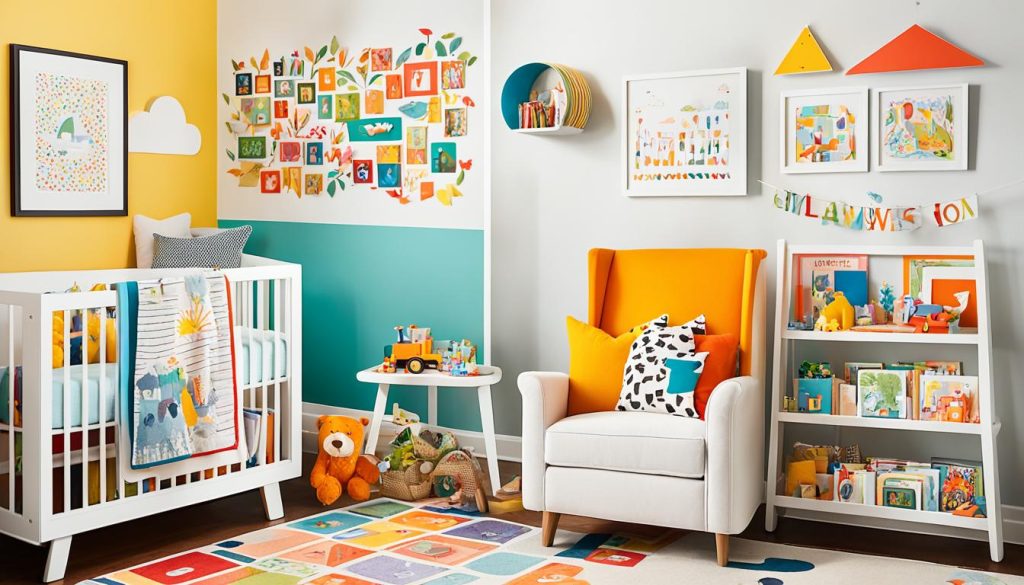
Begin with family photos. Hang them in simple frames or make a collage. This is a quick and touching DIY project. For more personal flair, add a custom name sign or monogram above the crib.
Add handmade items for a unique touch. A knitted blanket or a piece of painted art can warm up the room. These projects are quick and can be done in the last few weeks of pregnancy, usually between weeks 28 and 36.
- Frame special mementos
- Use meaningful quotes or song lyrics
- Display heirloom items
Personalized nursery decor doesn’t have to be expensive. One mom set up a nursery for less than $200, not counting the crib. She used her partner’s drawings in simple frames for a personal touch.
Our nursery setup had to be done quickly, but we made it feel cozy and welcoming.
With these ideas, you can quickly make a nursery that feels special and welcoming for your baby.
Tackling Common Challenges in Rapid Nursery Setup
Setting up a nursery quickly can be tricky. You might face space issues, struggle with choices, or encounter unexpected delays. Let’s explore some nursery setup challenges and smart solutions to help you create a cozy space for your little one.
Dealing with Limited Space
Small nurseries need creative thinking. In a compact 7’4″ x 8’9″ room, every inch counts. Use vertical space with tall shelves and wall-mounted storage. Pick multi-functional furniture like a dresser that doubles as a changing table. These small nursery solutions maximize your limited area.
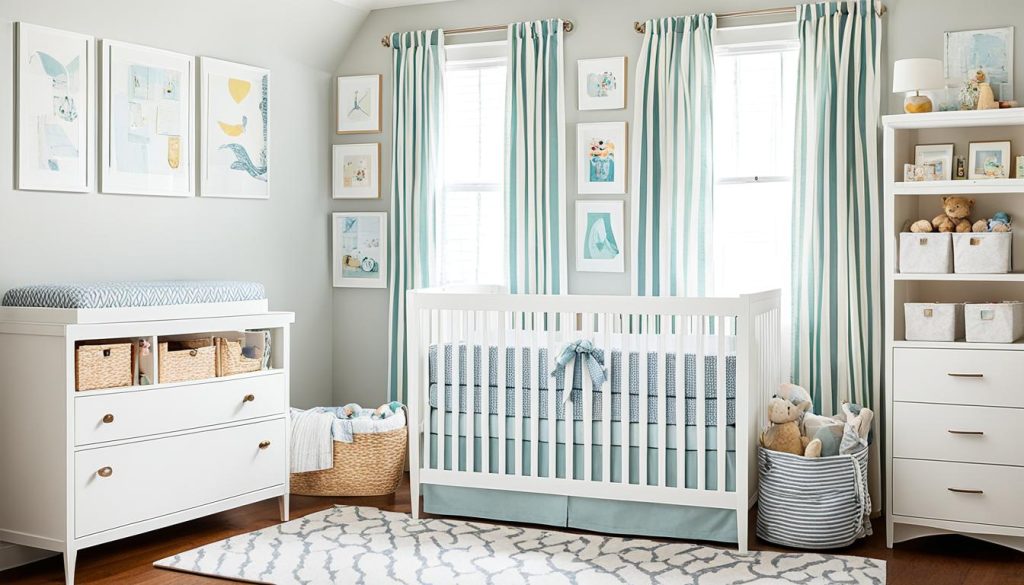
Overcoming Decision Paralysis
Choosing nursery items can be overwhelming. Set deadlines for decisions to avoid getting stuck. Limit your options to prevent endless browsing. Remember, you can always add or change things later. Focus on the essentials first – crib, chair, dresser, and changing pad.
Managing Unexpected Delays
Delays happen, but don’t panic. Prioritize must-have items and have a backup plan. If furniture delivery is late, consider temporary alternatives. Be flexible with your timeline. Some parents finish their nursery months after the baby arrives, and that’s okay!
Keep these nursery planning tips in mind:
- Choose versatile colors like River Rock by Benjamin Moore
- Add personality with art and sentimental items
- Use natural wood tones for contrast
- Create a cozy atmosphere with a mix of dark walls and bright accents
Remember, tackling nursery setup challenges is part of the journey. With smart planning and flexibility, you’ll create a beautiful space for your baby, no matter the timeline or room size.
Essential Baby Items to Have Ready Before Birth
Getting ready for your newborn can feel like a lot, but having the right nursery items helps. Let’s look at the must-have newborn items to get before your baby comes.

Begin with a safe sleep area. Pick a crib or bassinet that follows safety rules. Make sure it has a firm mattress and fitted sheets. For safety on the move, get a car seat that fits your car.
Diapers are crucial. Think about eco-friendly choices like Nora’s Nursery pocket diapers or Seventh Generation or Honest Company disposables. Also, get gentle wipes. A portable changing pad is great for changing diapers at home.
- Clothing essentials: onesies, sleepers, and swaddles
- Feeding supplies: bottles, breast pump, and burp cloths
- Bathing items: baby wash, soft towels, and gentle lotion
For baby’s skin, choose natural products. Coconut oil, Earth Mama, or Badger Baby Balm are good for diaper cream. Go for fragrance-free baby wash or goat milk soap for baths. A basic first-aid kit with grooming items is also a must.
“Having these baby registry must-haves ready by week 36 of pregnancy can help you feel prepared and confident for your newborn’s arrival.”
Don’t overlook feeding essentials. If you’re breastfeeding, have both manual and electric pumps. For bottle-feeding, get different types like glass or ergonomic ones. Keep extra pacifiers ready for when your baby needs them.
Lastly, think about storage like a toy chest to keep your nursery tidy as gifts come in. With these newborn essentials ready, you’ll be set to welcome your baby home.
Closing Thoughts
Setting up a nursery quickly can be tough, but with good planning, you can make a cozy spot for your baby. Focus on the must-haves while keeping things flexible. Start with safe, useful furniture like a crib, dresser, and glider from trusted brands that follow safety rules.
Think about choosing themes like jungle, mountains, or rainbows for your nursery. These themes are easy to change as your child grows. Make sure to add safety features, like securing furniture and using cordless blinds. Paint the room early, at least two months before your due date, to keep it safe from fumes.
Even though planning well is key, you don’t need everything perfect right away. Your nursery can change over time. Aim to make a safe, welcoming space with room for more items later. By the 36th week, try to have the main items ready, like clean clothes sorted by size. With these steps, you’ll be ready for your baby’s arrival and enjoy parenthood in a well-thought-out nursery.

